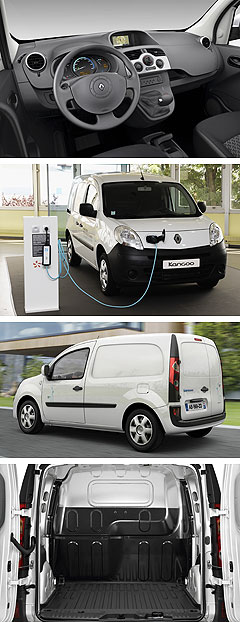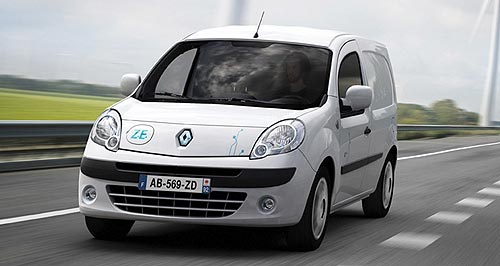Future models - Renault - Kangoo - ZEFirst drive: EV Kangoo may do for OzSpark of interest: The all-electric Renault Kangoo ZE is a chance to join the Fluence ZE in the French brand's local line-up from 2012. Renault is poised to offer world-first electric delivery van in Australia24 Oct 2011 By BYRON MATHIOUDAKIS in PORTUGAL IN A key commercial vehicle product offensive as well as an historic Australian first, Renault is set to soon start selling an electric version of the Kangoo delivery van locally against the top-selling Volkswagen Caddy range. Although not yet confirmed, the two-seater short-wheelbase Kangoo ZE (for Zero Emissions) van will most likely join its petrol- and diesel-powered siblings sometime from 2012. Pricing has yet to be determined, but in Europe the ZE attracts a modest premium, starting off from about $A25,000. “Renault Australia is exploring the business case … although there is nothing to announce right now,” said Renault Australia spokesperson Emily Ambrosy. EV infrastructure and maintenance specialists Better Place are expected to provide exclusive battery leasing and servicing deals for the Kangoo ZE. It will be Renault’s second EV offering after the Fluence ZE four-door sedan that arrives in dealerships Down Under in the last quarter of next year. That model will also have its battery leased through Better Place. Only a single short-wheelbase (2697mm) two-seater van with a glazed sliding side door is thought to be near the starting block for now, though a long-wheelbase (3081mm) body is also available should demand dictate. In Europe, where Renault dominates the light commercial vehicle sector with almost 16 per cent of the market, there is also a five-seat passenger LWB Maxi model on offer. This is also under scrutiny for Australia. Significantly, Renault is breaking new ground around the globe for an LCV as electrified rivals sold in other countries, such as the Ford Transit Connect, Fiat Doblo and Citroen Berlingo, are all aftermarket EV conversions.  Developed as part of Renault’s circa-$5 billion electrification program that will also usher in the Fluence, Zoe and Twizy ZEs, the Kangoo ZE differs from the Australia-bound Fluence in not having a switchable – or ‘Quick Drop’ in Renault-speak – battery pack. Developed as part of Renault’s circa-$5 billion electrification program that will also usher in the Fluence, Zoe and Twizy ZEs, the Kangoo ZE differs from the Australia-bound Fluence in not having a switchable – or ‘Quick Drop’ in Renault-speak – battery pack.Instead, its lithium-ion cells are always plug-in charge-reliant (via a flap located between the headlights – the only real visual giveaway to this van’s electrification after the blue-tinged badging), and are positioned horizontally in a fixed position beneath the floor, for what Renault says is an excellent low centre of gravity. It also means the Kangoo’s cargo space remains at a very competitive three cubic metres, the load length is 2.9m (with the front passenger seat folded onto itself) and the payload is unchanged at 650kg. With a 1.21m width between the rear wheelarches, a standard European pallet can be easily loaded, aided by two-stage hinged rear barn doors. Regardless of braking, the ZE van’s tow weight is rated at 374kg. Mounted in the nose is an electric motor channelling 44kW of power (at a heady 12,000rpm) and 226Nm of torque to the front wheels via a single-speed gearbox. The 260kg lithium-ion battery has a nominal capacity of 65Ah, produces 398 volts, contains 48 modules and 192 cells, and offers 22kWh of energy. In the newly devised European NEDC range cycle, Renault’s electric van can manage 170km on one charge, but drops to about 80km if driven hard, over demanding terrain, in unfavourable weather extremes or when fully laden. Renault-supplied research suggests that 70 per cent of European van users drive less than 100km daily. Range can be improved by 10 per cent by pressing an ‘Eco’ mode button that acts on the computer software to restrict power and speed. A special climate switch known as ‘pre-start’ allows drivers to pre-set the cabin temperature while the van is still charging, thereby not relying on the battery to heat or cool the interior once on the move, further extending range. Activated the moment the driver’s foot comes off the pedal, brake regeneration energy can also return up to 40 per cent of charge to the battery cells. In the event of imminent battery charge depletion, the Renault van resorts to a ‘reduced power’ mode that acts as a further warning and allows for a few extra kilometres of low-speed travel. This means the driver can exit off a main arterial to a nearby charge outlet or park out of harm’s way. The 1410kg Kangoo ZE takes a leisurely 20.3 seconds to get from standstill to 100km/h and its top speed is limited to 130km/h. An audible warning system is optionally available in Europe to alert pedestrians of a passing EV. The rack-and-pinion steering is also electrically powered and boasts a turning circle of 10.7 metres. To keep development costs and pricing down to an affordable level, electronic stability control is not available. Interestingly, a Renault spokesman justified this by suggesting that the Kangoo ZE will not venture as far or be driven as spiritedly as a passenger car. Anti-lock brakes with electronic brake-force distribution and four-wheel discs are part of the package, however. Based on the old X84 Scenic II platform, the Kangoo ZE employs conventional MacPherson struts up front and a torsion beam rear axle, and rides on unique 195/65 R15 tyres. Interior clues to the Kangoo’s electrification are minimal. In addition to the aforementioned Eco button on the lower console area, the instrument pack includes a charge level and ‘econo meter’ gauge in lieu of a tachometer. Three airbags will be fitted as standard – dual front items and a driver’s side item. Like the Fluence ZE, the Kangoo ZE has undergone extensive 50km/h side and rear impact testing to ensure no battery pack intrusion. Sudden deceleration forces cut the power supply immediately to help eliminate the chances of electrocution. Along with no direct emissions, the electric van promises to cut maintenance costs by 20 per cent compared to the internal-combustion versions, while insurance rates in Europe attract discounts by up to a similar amount. Globally, the buyer profile for Kangoo ZE is expected to fall 80:20 in favour of fleets, though the SWB version might attract a slightly higher percentage of self-employed customers in Australia. France, the United Kingdom, Spain, Germany and Denmark will all see Renault’s ZE van before the end of this year, highlighting the importance of the series to its maker. Like all Kangoos, it is built at the firm’s Maubeuge facility in France. Drive ImpressionsTHIS is where the real EV fun begins. Sure, driving the Fluence ZE boldly brings affordable, practical and zero-emissions electric motoring into mainstream Australian households, but it is its delivery van sibling that had us really wanting more than just 50km or so of emissions-free scooting around.Just look at it – basic, honest and wearing the friendliest of smiles (though some might see the menacing look of a Cyberman in the headlights’ distinctive teardrop shape). The Renault is yet another example of how well the French have executed vans over the decades. Mind you, its stats do not look too appetising on paper – just 44kW of power and a 0-100km/h ‘dash’ time of 20-plus seconds. But the 226Nm of torque and 22kWh battery capacity deliver a velvety smooth low-speed punch that seems just right, especially as there is absolutely nothing other than seamless acceleration on offer courtesy of the reducer single-speed gearbox. It is true that this is by no means a fast or powerful vehicle, but the ZE feels more zingy and alive at urban speeds than you might expect, like it is always trying as hard as it can. The lithium-ion cells are placed low down in the middle of the van for optimum centre of gravity so, combined with the Kangoo’s wide stance and quick-witted electric steering, there’s ample opportunity for flat, fast and secure cornering, riding on a wave of electric torque. If only the Fluence ZE possessed this level of steering feedback and feel. Zipping up a mountainous road in rural Portugal, trying to deplete as much electricity from the battery pack as possible, the amount of available range was still on the right side of 80km, meaning that for most daily use, the Kangoo ZE delivers the goods in a pure and clean manner. We also applaud the Renault’s remarkably plush ride quality, while the appealingly simple and airy design approach to the interior, aided by deep side windows and comfortable seating, adds to its eager-to-please personality. On the other hand, the base of the front pillars provide appalling blind spots – it’s very noticeable through roundabouts, for example – while the brake-regeneration technology that partially recharges the battery when the driver goes off throttle is very pronounced, like the handbrake is being applied. Renault wisely offers a pedestrian warning sound option because people just kept walking in front of the Kangoo ZE without looking. But the omission of stability control – on cost grounds, according to one senior (French) Renault PR – is unacceptable, particularly when the VW Caddy has it as standard and Renault is supposed to be so safety conscious. Missing ESC to save money only serves to completely undermine that. Still, here’s a zero emissions workhorse that goes far beyond the sum of its parts (as well as power and range). Practical as well as pleasurable, if Renault Australia doesn’t release the Kangoo EV in Australia then we’re going to call the fun police.  Read more7th of October 2011  No halt for Renault Australia growthRenault aims to continue sales momentum with new models and bigger dealer networkKangoo pricing
Motor industry news |
Click to shareRenault modelsResearch Renault Kangoo pricing
Motor industry news |
















Facebook Twitter Instagram